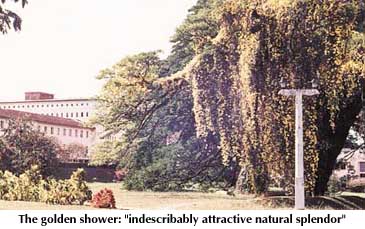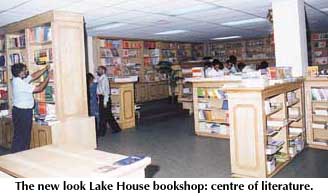

![]()
Peradeniya : Memories of a University. Edited by De Silva K. M and Jayatilaka, Tissa. Rs. 1250.00 International Centre for Ethnic Studies, Kandy, Sri Lanka 1997 pp200.
'Good-bye now, Plato and Hegel,
The shop is closing down'
-Louis MacNiece, from Autumn Journal
Looking back and remi niscing, taking stock, and looking to the future - these are all the conventional exercises duly undertaken by most, if not all organisations, institutions, clubs, societies, schools etc. in the course of their existence, at suitable and appropriate intervals. The University of Ceylon and its "lineal descendant", The University of Peradeniya are no exceptions.
To celebrate 50 years of the University's existence volumes of essays, with different scope and purpose, were published and, according to the editors of this volume of essays, they "had little or nothing on the lives of students at Peradeniya. This present publication was to fill this gap". This is a commendable exercise.
The beauty of the Peradeniya campus is legendary, what Jayatillake refers to as the "indescribably attractive natural splendour", and Markar as "the remarkable beauty of its breathtaking landscape". No one who has worked or studied here, or even been a casual visitor could be impervious to its beauty: the trees in bloom, the lawns, the buildings, the meandering river, the birds, the walks up the winding roads, the campus on a moonlit night, all overseen by the Hantana range. These are indelible memories referred to in many of the essays. Gunesinghe describes the "Golden Showers" (Macfaydenia Unquis Cati, to the uninitiated) draped over the mara trees - inspiring and sustaining her in her preparation to pass the U. E. examination in order to "be among the fortunate few who would gain admission that year".
 Stanley
Kirinde's four paintings and drawings (on the inside covers) have a gentle
and tranquil quality, emphasizing the quasi -pastoral settings of the campus.
There are no humans, animals, motor vehicles, carts etc. in the paintings
"to disturb the air". If there is one criticism here, it is that
the paintings (plates) are not numbered, and not assigned a page number
in the contents.
Stanley
Kirinde's four paintings and drawings (on the inside covers) have a gentle
and tranquil quality, emphasizing the quasi -pastoral settings of the campus.
There are no humans, animals, motor vehicles, carts etc. in the paintings
"to disturb the air". If there is one criticism here, it is that
the paintings (plates) are not numbered, and not assigned a page number
in the contents.
The gradual transformation of Peradeniya from its idyllic (in more ways than one) state in the fifties to the complex and issues-charged atmosphere of the later years is introduced in the essays of Gunasinghe, de Amarasinghe and Malalgoda. Their essays, and the later ones, bring out the whole catalogue of changes: increasing student numbers, the gradual reduction of the amenities associated with the residential life, overcrowding in halls and lecture rooms, the introduction of the mother tongues as the media of instruction and the decline in competence in English, the down grading of the one-time admired and prestigious Faculty of Arts, the violent aspects and "politicization" of the rag, "political struggles", and the growing alienation, as well as apprehension of students regarding employment.
All the essays make for easy reading, as well as being instructive. I read them in the order set out in the book. If there is any unevenness it may be in that thirteen of the essays are by former students of the Arts, Humanities and Social Science persuasion.
The Veterinary, Dental, Medical and Engineering faculties are written about by 'pioneers', whereas the Arts has a wider spread which was perhaps unavoidable.
The authors are all identified by their names only, without accompanying qualifications, designations, gender etc. This is in keeping with the general thrust of the book, and also brings a touch of intimacy and informality. I liked that.
A few criticisms are not out of place here. To begin with although "every faculty in the university was to be represented", the faculties of Law and Agriculture, the first to arrive at Peradeniya, are not represented. The Law faculty subsequently moved to Colombo while Agriculture expanded from less than ten students per batch to over 175 today.
The authors, even as students, were more than competent and comfortable in English which would probably lend a certain hue to their accounts. It would be interesting to read a similar exercise, written in Sinhala and Tamil, by graduates who have studied in the Swabasha medium.
The essays with a specific scope and style, and not meant for a scholarly journal, will nevertheless serve as important source material for writers of history and sociology in the years to come.
It would be appropriate to end this review with reference to Jennings, since Peradeniya was Jennings's. De Silva writes affectionately of his "reassuring presence on the campus, a familiar figure...."
Ashley Halpe recalls his walking "the campus roads in the evening, a benign and energetic headmaster".
Regrettably there is nothing in Peradeniya to commemorate this great man (lovingly remembered in the Ceylon University Magazine of November 1955). There is no building, Hall of Residence, Road, Library, Prize or Scholarship in his memory. His portrait hangs in the Senate and many "Senators" today may not recognise the lean, bespectacled figure flanked by the portraits of Soulbury and the "Iron Vice-Chancellor" Attygalle. We await the definitive biography of "the real architect of the campus."
His concept of the University, like some other things in Sri Lanka today, are gone by the board, and regrettably so. In many ways this was probably inevitable, given the changes in the country over the years. Students will continue to come to Peradeniya with expectations, and with little or no idea of its past. It is for the present generation of teachers and students to chart what the University of Peradeniya is to be in the next century. And good luck to them.
New bookshops had sprung up over the years, but since the shifting of the Lake House Bookshop to its present location in 1965, the city's most famous bookstore had undergone little or no change.
But when a huge crowd of eager book lovers converged on the Fort bookstore last month to meet Booker prize winner Arundhati Roy, they were pleasantly surprised. The bookshop had a new look, in keeping with modern concepts."With the 50th anniversary of Independence of Sri Lanka and the approach of the 21st century, Lake House Bookshop has caught up with the times," quipped Manager Sarath Silva.
Originally began as an Associated Newspapers of Ceylon Limited (ANCL) club, then home library formed for members, Lake House Bookshop soon acquired a large clientele. Today, it has the look of an international bookstore. With a bright cream and yellow interior, new furniture and the opening of large windows which enable passers by to look inside unlike the earlier covered windows, the book shop seems to have successfully merged the needs of the present with its past.
The more spacious, more organised interior which also has more on offer, is the creation of interior decorator Mr. De Vos."Along with the new look, we have increased our range of books as well. We have increased our collection of books relating to various professions such as law and management and also have separate sections for each of these subjects," said Mr. Silva. That is not all. The bookshop is to be computerized while soft music is also in the pipeline.
 "Once
all this is done we can safely say that we are on par with world class
book shops," said Mr. Silva.
"Once
all this is done we can safely say that we are on par with world class
book shops," said Mr. Silva.
According to Mr. Silva, they have tried to preserve the historical nature of the place. Having been to Britain to study the world famous bookshop, "Dillon's," he said he was greatly influenced by this. "I noticed that many of the famous bookshops had a large window displaying the inside of the shop, which is why we decided to open up our window as well."
"After the refurbishing, the earlier crowded atmosphere has disappeared, and the storage capacity has doubled which means that there are more books on offer and more space to walk around."
The new look which cost around Rs.8 million also comes with several new programmes of which the visit of Arundhati Roy was only the first. Every month the bookshop intends to have a programme called 'meet your author', where readers can meet their favourite authors, especially Sri Lankan authors.
Also, a separate wide collection of Sinhala and other language books are on offer.
All books will be subjected to a 10% discount from mid January. Books on Sri Lanka will be on a discount up to 50% depending on the title, as a celebration of the 50 years of Independence.
The management also hopes to make the Lake House Bookshop the centre of literature, or "Sahithyamaya Kendreya' as they call it.
Readers can also look forward to having various other programmes, such as cookery demonstrations. Sofas to help clients relax and read books before purchasing will also be installed. At the same time, client-server monitoring has also been introduced where the Manager can spot customers who are in need of help from his office and direct his employees to assist them.
These are only a glimpse of what the bookshop holds.
But, the management assures that there are some more surprises to follow. Of course, one has to be there to experience the difference.
Continue to Plus page 9 * The dark side of enlightenment
Return to the Plus contents page
![]()
| HOME PAGE | FRONT PAGE | EDITORIAL/OPINION | NEWS / COMMENT | BUSINESS
Please send your comments and suggestions on this web site to
info@suntimes.is.lk or to
webmaster@infolabs.is.lk